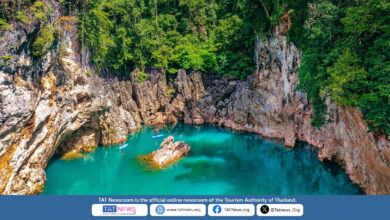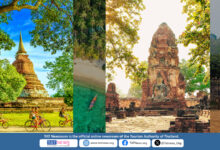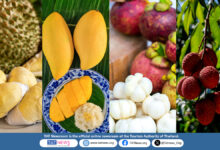Bangkok is a fun and fascinating city, but occasionally, tourists and residents alike feel the need to get away from the bustle and crowds to explore attractions further afield. So, come the weekend, the roads are full of families heading to the provinces.
Some people love vibrant Pattaya while others prefer the quieter beaches or Hua Hin, or the hills of Khao Yai – all charming destinations. But after a while, you might feel that Pattaya is a little too popular, or that Hua Hin seems less laid-back than it once was.
So if you’re seeking an entirely new getaway, let us pitch Phetchaburi to you. Overlooked and understated, the province not only offers an easy escape from Bangkok, but boasts enough attractions to keep you exploring for months.
The western half of the province is covered by Thailand’s largest, and least explored national park, Kaeng Krachan, home to some of Asia’s most elusive and exotic animal species.
History fans will be happy here too, as Phetchaburi was once part of the 11th century Khmer Empire of Angkor and there are some well-preserved remains of the Empire in Phetchaburi city. The region was important during the Sukhothai and Ayutthaya periods and these kingdoms have left their mark, too. There are also natural wonders, palaces, temples and markets just waiting to be discovered.
So let us introduce you to the pleasures of Phetchaburi.
The regal caves of Khao Luang
Sleepy Phetchaburi town boasts wonderful relics and temples, but the most popular attraction is a natural wonder, just beyond the town’s centre – Khao Luang Cave. This deep cavern is hidden deep within the 100-metre Khao Luang and is reached by descending a steep staircase, seemingly guarded by thieving local monkeys – so keep a firm grasp on your belongings.
Once in the cave, you’ll find a huge cool space filled with Buddha images and stalagmites, but it’s the golden beam of sunlight, from a hole in the roof which makes the cave so photogenic. Khao Luang is locally revered – the main Buddha image here was commissioned by King Chulalongkorn the Great, and his influential father King Mongkut or Rama IV used the peacefulness of the cave for his meditation.
The cave also plays its part in Thailand’s tourism history – Khao Luang was a stop-off for Siam’s earliest Western visitors including Henri Mouhot, who is famous for exploring the temples of Angkor. He made a well-known etching of Khao Luang for his records, and it’s nice to see that the cave remains much as it did in 1864. Except now of course, you can take a convenient pickup truck right to the entrance.
The caves are open every day from 09.00-16.00 Hrs. Admission is free, but there is a small charge to get the pickup trucks to the entrance and back.
Heaven on a hill – Khao Wang Palace
If you’re visiting Phetchaburi Town, you can’t miss Khao Wang Palace, literally. It rises above the city on its huge green hill and is crowned with a mighty white stupa – it seems a heaven-made royal residence. So it’s strange that Khao Wang Palace, built by King Mongkut as a summer residence, is so little-known.
As a natural wonder, it’s impressive enough, but the buildings, which blend Thai, Western and Chinese architecture, make it unique. You can scale the steep path to the summit, but most visitors take the cable car, which climbs the 93-metre hill smoothly at a steep angle – there can’t be many more elegant ways to ascend a slope.
Once atop, you can explore the small palace on the western peak, which hosts a museum and the Italianate observatory from which King Mongkut, (often called the father of Thai science), used to observe the heavens. There is also a temple on the eastern hill modelled after Bangkok’s famous Wat Phra Kaeo.
But the real pleasures of Khao Wang Palace come from wandering around the beautiful pathways that criss-cross the hill. There are flowering trees that cast lovely shadows, cool breezes and amazing views of the town and plains below – the perfect royal venue in fact.
Khao Wang is open from 08.30-16.30 Hrs. with the last entrance to the museum being at 16.00 Hrs. Entry is 150 Baht per person.
Charming Cha-Am Beach
In tourist guides, it’s always Hua Hin in nearby Prachuap Khiri Khan, which is described as sleepy and laid-back. But these epithets better describe Phetchaburi’s lovely beach town of Cha-Am, which remains relatively undiscovered by international tourists. Cha-Am retains a relaxed family vibe, which is intoxicating if you’re seeking to put the world on hold for a couple of days.
Most visitors lounge under beach umbrellas while vendors deliver plump prawns and cold drinks. But if you do explore, you’ll find great seafood restaurants, an improbably long pier and a picturesque fishing village where you can buy fresh fish at bargain prices.
The dreamy piers of Maruekhathaiyawan Palace
If the pleasures of the beach get too tranquil, take a trip to Maruekhathaiyawan Palace, which was built in 1923 by King Vajiravudh (Rama VI) as a seaside health retreat. Known as the Palace of Love and Hope, Maruekhathaiyawan really offers the ultimate in beach luxury. The main structure was designed by the king himself, working with the renowned Thai-based Italian architect Ercole Manfredi.
The standout features are two long walkways that stretch to the sea to ensure private bathing. Recently restored, and set in gorgeous gardens, Maruekhathaiyawan has to be one of the most beautiful of all the royal residences in Thailand. You can explore the royal quarters, which house some of the king’s belongings including his bed and his desk where he may have worked on his translations of Shakespeare.
Maruekhathaiyawan Palace is open every day (except Wednesday) from 08.00-16.00 Hrs. Admission is 60 Baht a person. As this is a Royal Palace appropriate attire must be worn, meaning no short pants or skirts.
The natural wonders of Kaeng Krachan National Park
Straddling half of the province of Phetchaburi, Kaeng Krachan is Thailand’s largest national park. It is 2,914 square-kilometres and links with the extensive Western Forest Complex that extends into Myanmar, making it one of Asia’s most important nature reserves – so you’ll need a few days to discover even a few of its treasures. On the Thai side, Kaeng Krachan is fed by the Phetchaburi and Pranburi Rivers and at its highest point reaches 1,500 metres on the border.
People come to the park hoping to see some of the wildlife, which includes over 430 bird species including hornbills, and mammal; such as, leopards, bears, macaques, gaurs and wild elephants. There are also waterfalls and caves to explore off the park’s trails. The amazing scenery is at its best during the cooler months, from December to March, when the hilltops pierce the morning mists like magical islands.
It is possible to camp in the park, but you’ll need a guide if you want to venture further into the forest. Day visitors head for the Kaeng Krachan Dam where there are some good walks and trails with scenic views.
Innovative Wat Khoi
Visiting temples is something that every visitor to Thailand does at some point. But we’re so used to seeing ancient or renowned wats, that we often forget that temples are still being built. Phetchaburi’s Wat Khoi allows you to get a glimpse of a work in progress and enjoy some whimsical modern touches in a building that’s sure to become one of Phetchaburi’s most beautiful sites.
Unusually, Wat Khoi features Thai musicians as statues around the main temple building and if you look carefully enough, even a temple guardian with the Liverpool Football Club etched on its body. Wat Khoi boasts a curious blend of classical and modern Buddhist art, and there’s an amazing high-relief mural featuring contemporary figures and mythological characters. Traditionalists shouldn’t miss the amazing scenes from the life of the Buddha rendered in a classical style inside the main building.
Other ancient temples
Phetchaburi has many ancient sites, but the most important is Wat Yai Suwannaram (above gallery), parts of which date back to the Ayutthaya period. The oldest structure here is the teakwood Sala Kan Prian or sermon hall, which was once located in Ayutthaya’s Grand Palace and is famous for its intricate wood carvings around the doors.
Nearby is the main temple building where you can see 400-year-old murals featuring unique characters; such as, giants, each image given real personality by talented artists. The temple’s ancient library nearby is precariously perched on stilts in the middle of a reservoir, a way of preserving the ancient texts from insects.
Another ancient Phetchaburi temple worth seeing is the Khmer Wat Kamphaeng Laeng, which dates from the 12th century and is home to the most southerly Khmer temple building in Thailand.
Weekends of wonder await, these are merely a handful of the attractions that await you in Phetchaburi. There are many more we could list – but why not go find them for yourselves? After all, if ever ultra-modern Bangkok feels like it’s getting a little too much, you have an ancient empire on your doorstep, just waiting to be explored.
Getting there: If you have a few days free, Phetchaburi town is a good place to base yourself to explore the region. The fastest way of getting there from Bangkok is to take a mini bus from the Victory Monument area. The trip takes around two hours.
*fishing village of Cha-am, Phetchaburi












































